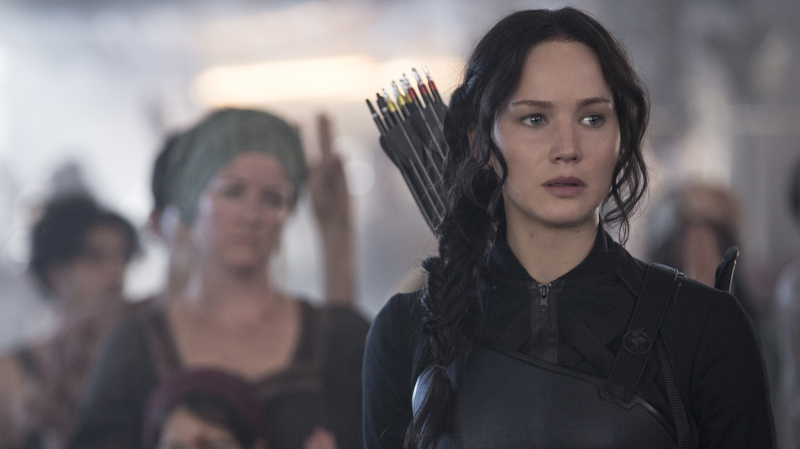When producers were laying track for the Hunger Games series years ago, they couldn’t have foreseen how discomforting author Suzanne Collins’s descriptions of a war-torn authoritarian state would look on the big screen in 2014. In The Hunger Games: Mockingjay – Part One, Jennifer Lawrence witnesses and/or learns of: towns reduced to rubble, refugee camps next to mass graves, public executions of innocents with burlap sacks over their heads, law enforcement gunning down protesters in the street, and a military bombing a hospital filled with civilians. All of these images have resonance in real events of this year, generations before Collins predicted civilization would devolve into a regime that maintains control over its citizens with televised death matches.
The series has always evoked real geopolitics, but the earlier films offset those with self-parody: an abundance of purple hair and oily camera-ready suits, an outlandish imperial march composed by Arcade Fire. This playfulness is absent from Mockingjay, which is laser-focused on the land of Panem quashing dissent by any means necessary. It’s not that the film is “too dark for kids” — that would drastically underestimate teenagers’ capabilities for darkness. It’s that this degree of nastiness doesn’t square with the empty-calories action scenes of the first two films, where nothing that happened in the Hunger Games arenas (look out! Wild monkeys!) seemed to impact the overall story.
But maybe it’s a good thing to be more serious this time, even if the progression wasn’t gradual. “A little on-the-nose, but, of course, so is war,” remarks the dearly departed Philip Seymour Hoffman, playing an architect of the Panem resistance movement. He’s referring to a tweak he’s made to a rally song, but he could also be discussing Mockingjay itself, how a mass appeal sci-fi franchise chooses its war imagery. In a film about the role that visual communication plays in public opinion, the on-the-nose approach is at once intriguing and exhausting. Strange to think this series used to be about archery in the wilderness.
That, anyway, is where fiery revolutionary Katniss Everdeen (Lawrence) was at the conclusion of the previous film, 2013’s Catching Fire. Rejecting society’s pressure to kill her friends for amusement a second time, Katniss instead shot a hole in the sky, through which she has been whisked away to the super-secret underground rebel stronghold District 13. In the first two films Katniss was a pawn of Panem’s dastardly, white-bearded President Snow (Donald Sutherland, forever sneering). Sadly, she’s still a pawn, but of a nobler president, the benevolent but still white-haired District 13 leader Alma Coin (Julianne Moore, a hair too robotic). Coin needs Katniss to be her “Mockingjay,” a symbol around which to mobilize the citizens of Panem: a warrior who’s no-nonsense, yet down-to-earth. In short, she needs Katniss to be Jennifer Lawrence.

9(MDAxOTAwOTE4MDEyMTkxMDAzNjczZDljZA004))

